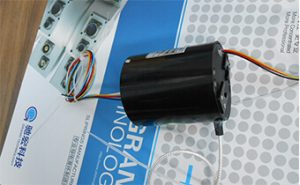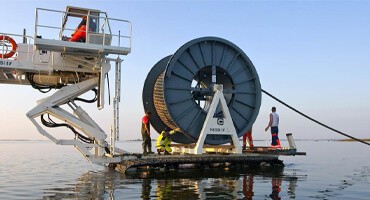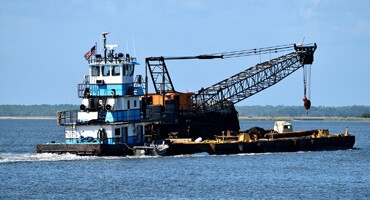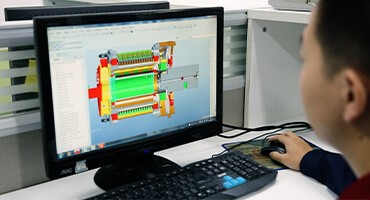Introduction
Slip rings are crucial components in electrical engineering, and they play a significant role in various industries due to their ability to transfer electrical signals and power between stationary and rotating components. This comprehensive guide aims to provide an in-depth understanding of slip rings, their applications in electrical engineering, current trends, future predictions, challenges, and potential solutions.
Basics of Slip Rings

Slip rings are fundamental components of most systems involving rotating parts in electrical and electronic engineering. Their primary function is to establish an electrical connection between stationary and rotating parts in a system, thereby enabling the smooth transmission of power or signals.
The basic construction of a slip ring assembly, often described as a rotary electrical interface, rotating electrical connector, or even commutator, involves two primary elements: the rings and the brushes. The rings, made from a conductive material such as copper or gold, are attached to the rotating part of the system, forming what is known as the rotor. These rotate with the mechanism, such as a wind turbine rotor or the panning part of a CCTV camera.
In contrast, the brushes, also made of conductive materials, are a part of the stationary component referred to as the stator. They are designed to make sliding contact with the rings as they rotate. The brushes are connected to the static part of the system. They create a physical connection with the rings, enabling electricity or data to flow from the stationary part of the system through the brushes to the rotating parts or vice versa.
The basic working principle of the slip ring is founded on this structural configuration. As the system rotates, the rings and brushes maintain contact, ensuring the transmission of power or signals despite the rotation. The current or signals pass through the stationary brushes, into the rings, and then onto the rotating part of the system, enabling functionalities like motor rotation, data transfer in computer systems, or power supply in generators.
Regardless of the application, slip rings effectively resolve the issue of transmitting electrical signals or power in rotating systems, eliminating the operational limitations imposed by twisted wires and ensuring a system’s efficient and reliable operation. The slip ring’s design, size, and material can be adapted to fit a wide range of electrical and electronic applications, providing a versatile solution for various engineering needs.
It’s this simplicity, flexibility, and efficiency provided by slip rings that make them irreplaceable components in many modern engineering systems. Without slip rings, many operations in industries such as aerospace, defense, marine, telecommunications, industrial automation, and renewable energy production would be crippled. Hence, understanding the basics of slip rings is a significant step in harnessing their potential in these numerous applications.
Application of Slip Rings in Electrical Engineering
In the realm of electrical engineering, slip rings have found extensive application due to their consistency in signal transfer and ability to prevent wire twisting issues.
Power Generation
Power generation, especially in renewable energy systems, has emerged as one of the main applications of slip rings. The primary attribute of generating power through renewable sources such as wind or hydro is the constant movement and rotation. It is in this context where slip rings play a critical role in transmitting generated power from the rotary part of the system to a stationary grid.
Wind Turbines

Wind turbines convert kinetic energy from the wind into electrical power. When wind blows on the turbine’s large rotor blades, it causes them to rotate. This rotation drives a generator to generate electricity. The turbines are equipped with a nacelle, a component housing that contains crucial elements such as the gearbox, generator, and control systems.
The rotor blades and nacelle rotate around the main axis as they follow the wind’s direction to maximize energy capture. As the turbine rotates, it faces challenges in transmitting the generated power to the stationary grid without twisting cables or interrupting performance. This is where slip rings come to the forefront.
Slip rings are installed inside the wind turbine’s nacelle, typically between the main shaft and the generator. They allow for the uninterrupted transfer of generated power and data between the turning rotor blades, the generator, and the fixed parts of the system, such as the power cable and stationary control systems. This seamless transfer of electricity enables reliable operation, minimizing maintenance requirements and avoiding downtimes caused by twisted cables.
Hydroelectric Power Plants
In hydroelectric power generation, water flow is used to drive a turbine, which then powers a generator to produce electricity. In some instances, the rotating turbine shaft connected to the generator may require slip rings to transmit the produced electricity to the stationary part of the plant without inhibiting rotation.
For instance, Kaplan turbines, a type of adjustable hydroelectric turbine, use slip rings to transfer control signals and power between the stationary control system and the rotating turbine blades. This enables efficient regulation of the turbine blades to optimize energy capture and conversion.
In summary, slip rings have proven to be a vital component in power generation systems, particularly those involving renewable energy sources. By providing a continuous and reliable transfer of power and data in rotating systems, such as wind turbines and hydroelectric plants, slip rings help ensure maximum efficiency, reliability, and performance in power generation applications.
Communication Systems
In the field of communication systems, slip rings play a crucial role in maintaining a seamless signal transmission within continuously rotating systems. This uninterrupted flow of signals and data is vital for the optimal performance of various communication devices. Below, you’ll find a description of some communication systems where slip rings significantly impact the efficacy and reliability of signal transmission.
Radar Systems

Radars are communication systems used for detecting and locating objects through the emission and reception of radio waves. These systems require rotating antennas that consistently emit and receive signals in every direction to cover a complete 360-degree range. As the antenna rotates, the electrical connection must be maintained to transmit and receive signals without any loss or distortion.
Slip rings are incorporated into radar systems to ensure a steady flow of power and signals between the stationary and rotating components of the antenna. They play a critical role in maintaining the integrity of transmitted and received data, despite the constant rotation of the antenna. This seamless connection between the rotating and stationary parts allows for continuous and accurate operation of the radar, providing real-time information to track objects efficiently.
Satellite Communication Systems
Satellite communication systems employ ground antennas that must continuously rotate to maintain accurate alignment with orbiting satellites. This continuous movement is essential to ensure stable communication links with a satellite irrespective of its movement or position.
To facilitate the uninterrupted transmission of signals between moving and stationary parts of the antenna system, slip rings are integrated into the assembly. The slip rings provide a reliable connection that allows the transmittal of power and data signals between the rotating antenna and the stationary control systems on the ground. As a result of the slip rings’ assistance, satellite communication systems operate seamlessly and with minimal disruptions.
Cable Reels and Retractable Cord Systems

For cable reels and retractable cord systems employed in telecommunications, slip rings also play a significant role. These systems require a continuous electrical connection as cable or cords are wound or unwound while they’re being used. Slip rings are integrated into the reel assembly, ensuring a steady power and signal flow between the fixed power source and the rotating reel, even during rotation.
In conclusion, slip rings play an indispensable role in various communication systems where continuous and smooth signal transmission is essential. By providing a reliable connection between stationary and rotating parts, slip rings enable the uninterrupted operation of radar systems, satellite communication systems, cable reels, and other communication devices that require absolute precision and consistency.
Robotics
Robotics is an interdisciplinary branch of engineering that involves the design, construction, and use of machines (robots) to automate tasks. In robotics, slip rings play an integral role, facilitating the transmission of power and signals between static and moving parts of a robot, most notably in robotic arms and wrists.
Robotic Arms

In robotic arms, joints and limbs require rotation to move and manipulate objects in various directions. These rotations challenge the electrical connections as they need to maintain the flow of power and signals to the motors and sensors located in the moving parts of the robot. Slip rings employed in these situations offer reliable connectivity and play a key role in the flexible manipulation of robotic arms.
Within a robotic arm, a slip ring can be integrated into each moving joint. While the joint is in motion (rotating), the slip ring ensures a constant electrical connection between stationary control units and the rotating arm. Therefore, power for the motor and data from sensors can flow without interruption or the need for complex, restrictive cabling.
Moreover, these slip rings can be designed to transmit multiple channels of control signals or power to optimize the speed, precision, and accuracy of the robotic arm.
Robotic Wrists
Markedly, the end section of robotic arms, often known as robotic wrists, needs to rotate and tilt with a higher degree of freedom to achieve precise handling of objects in all directions. Here, the use of slip rings is even more vital, as they provide an essential electrical link between the rotary wrist and the stationary arm, enabling power and data to be continuously provided to the end-effector, such as a gripper, cutter, or welder.
These slip rings are specifically designed to be compact, enduring, and able to handle multiple electrical connections simultaneously. They have the ability to transmit a combination of power, sensor data, video signals, and control signals between the stationary base and the rotating parts of the robot.
In summary, the integration of slip rings in the field of robotics contributes significantly to improving the versatility of robotic arms and wrists, as they ensure consistent and uninterrupted transmission of power and signals. This results in robots that can perform more complex movements, have longer lifecycles and produce more reliable and precise results.
Marine Technology

Marine technology encompasses a broad spectrum of applications, ranging from shipbuilding and maritime navigation to underwater exploration and offshore energy production. In this arena, slip rings are key components that ensure reliable power and signal transmission, despite the challenging operational conditions presented by the marine environment.
Ship Propulsion
In various types of vessels, from cargo ships to submarines, slip rings are integrated to facilitate the operation of revolving equipment like propellers and thrusters. For instance, in azimuth thrusters—a type of propeller that can rotate 360 degrees around the vertical axis—slip rings are employed to provide a steady power supply, control signals, and data transmission between the stationary control unit and the rotating thruster. By doing so, they contribute significantly to the maneuverability, navigation, and efficient propulsion of marine vessels.
Offshore Wind Farms
In the realm of offshore energy generation, particularly in offshore wind farms, slip rings play a crucial role. Like their onshore counterparts, offshore wind turbines convert wind energy into electrical power. However, they face more formidable challenges due to a harsher operating environment, rife with high humidity, salt spray, and extreme weather conditions.
Slip rings used in offshore wind turbines are specially designed to withstand these adverse conditions, without compromising their primary function: to transfer electrical power and control signals from the rotating blades and nacelle to the stationary parts of the system. They ensure the smooth functioning of offshore wind turbines by providing a reliable and continuous connection, even under constant rotation and hostile environmental exposures.
Underwater Systems
In underwater systems, including remotely operated vehicles (ROVs) and autonomous underwater vehicles (AUVs), slip rings contribute to their operational capabilities. These submersibles use rotating equipment for propulsion and maneuvering, necessitating reliable electrical connections to maintain a continuous flow of power and signal transmissions.
Customized slip rings are used in these applications, ensuring that the vehicles can operate effectively below water. They are constructed using materials that can resist water corrosion and have sealing features to withstand high-pressure conditions typical of underwater environments.
To conclude, slip rings are an invaluable component of marine technology, enabling smooth, uninterrupted operations in diverse applications, including ship propulsion, offshore wind farms, and underwater systems. In these contexts, they assure a stable transfer of electrical power and communication signals, upholding the overall performance and efficacy of marine technologies.
Current Trends
In an increasingly digital and interconnected world, technologies are ever-evolving. As these advancements sweep across various industries, the field of slip ring technology is no exception. Several current trends are shaping its development and application, enhancing its performance, use cases, and durability.
Miniaturization
As systems and devices become more compact and complex, there is a growing demand for miniaturized slip rings that offer the same functionality as larger counterparts while occupying less space. This trend is particularly evident in sectors like consumer electronics, aerospace, and medical devices.
The miniaturization of slip rings requires careful craftsmanship and advanced manufacturing methods to ensure the slip rings maintain a high level of performance, signal integrity, and reliability, despite their smaller size.
Integration of Advanced Materials
The incorporation of advanced materials such as precious metal alloys and composite brushes is gaining momentum. These materials improve the durability and performance of slip rings, particularly in scenarios with constant rotation or harsh environmental conditions.
Via lower contact resistance and improved conductivity, these advanced materials increase the performance of slip rings by ensuring a more efficient transmission of power and signals, reducing signal noise, minimizing temperature rise, and extending the operational lifespan of these devices.
Wireless Slip Rings
In line with the trend towards wireless technology, there has been an exploration into the development of wireless slip rings or ‘contactless’ slip rings. These are designed to provide rotary transmission of electrical signals or power using magnetic or radio frequency coupling, eliminating the need for a physical connection.
Although this technology is in its early stages, it poses a solution to challenges in standard slip rings, such as wear and tear caused by mechanical contact and the need for frequent maintenance.
Customization
Given the wide range of slip ring applications across different sectors, each with its unique requirements, there’s an increasing trend towards customized solutions. Manufacturers are investing in capabilities to create slip rings that meet the specific needs of their clients, whether it’s particular resistance to environmental conditions, specific performance characteristics, increased power or data transmission capabilities, or a unique size or shape.
This trend ensures the continued applicability and relevance of slip rings in various industries by addressing the unique challenges presented by different scenarios.
In conclusion, these current trends in the field of slip rings showcase a commitment to continuously improve and adapt this technology to the present and future demands
in terms of miniaturization, materials used, wireless options, and customizability. These innovations are propelling slip rings into a future where they continue to be critical components in numerous systems and applications.
Future Predictions
As we look toward the horizon of slip ring technology, several predictions can be made about its future development and evolution based on current trends and emerging technologies. Here are some of the prospective changes and advancements we can anticipate:
Proliferation of Fully Contactless Slip Rings
While contactless or wireless slip rings are still relatively new on the scene, it’s expected that they will become more prevalent in the future. This advent is likely to address the wear and tear issue commonly associated with traditional contact slip rings. By eliminating physical contact, these wireless solutions can offer increased durability, longer operational life, and reduced maintenance requirements which could prove revolutionary for industries such as renewable energy, aerospace, and heavy industry.
Development of Highly Miniaturized Slip Rings
With the continuous trend of device miniaturization, we can anticipate the development of micro or nano slip rings. These would be tailored for high-end technologies, like advanced medical equipment, drones, or compact robotics, inherently requiring smaller, lighter, more efficient components. Further research and advanced manufacturing techniques would be necessary to maintain high performance, signal integrity, and reliability in highly miniaturized slip rings.
Increased Demand for Customized Slip Rings
As slip rings continue to be integrated into a diverse array of applications with specific requirements and parameters, we are likely to see an intensifying demand for customized solutions. This shift could result in manufacturing companies offering a wider range of customization options—be it specific sizes, shapes, materials, or performance characteristics—catering to the unique needs of different industry sectors.
Integration of Smart Technology and IoT
Considering the rapid growth of the Internet of Things (IoT) and the prevalence of smart technology, it’s conceivable that future slip rings could be designed with these trends in mind. Smart slip rings could potentially include features such as condition monitoring, predictive maintenance, and remote control. With IoT integration, slip rings could be part of networked systems that provide real-time feedback about their operational status, flagging potential issues before they become critical.
Eco-friendly Slip Ring Solutions
With the growing global emphasis on sustainability and greener technologies, we might see a rise in eco-friendly slip ring solutions. This could involve the development of slip rings using materials that are recyclable or have a smaller carbon footprint, or the design of energy-efficient slip rings that contribute to lower power consumption in their respective applications.
In conclusion, the future of slip rings is likely to be shaped by advancements in technology, a drive towards customization, increased integration of IoT and smart technology, and a greater focus on sustainability. How manufacturers and industries adapt to these trends will define the next exciting phase of this essential technology.
Challenges and Solutions
Despite their significant attributes, slip rings face some challenges. These include signal interference, wear and tear, and environmental factors, in each of which various advancements are being made to address these concerns.
Signal Interference
One of the crucial challenges faced in the operation of slip rings lies in managing signal interference. Given their primary function of ensuring a continuous flow of electrical power and signals between stationary and rotating parts, dealing with signal interference is a top priority.
Signal interference, or noise, can disrupt the clear transmission of electrical signals, leading to erratic functioning or even failure of systems reliant on the slip ring. This interference can originate from various sources including electromagnetic fields, vibration, temperature deviations, or mechanical issues in slip ring operation.
Electromagnetic Interference
Electromagnetic interference (EMI), one of the most common sources of signal interference, emanates from the interaction of the signal-carrying channel with an external electromagnetic field. This can distort the signal during transmission, creating “noise” that can lead to misinterpretations or even loss of data. Minimizing EMI may involve using shielding techniques or noise-canceling solutions that keep the electrical signaling stable.
Mechanical & Vibrational Interference
Mechanical causes of signal interference often originate from the physical movement of the slip ring. Imperfections in the alignment of the rotatory and stationary parts during operation, or irregularities due to wear and tear, can disrupt the smooth flow of signals. Moreover, operational vibrations caused by movement in the application (like a rotating wind turbine or a moving vehicle) can also generate noise in the signal being transmitted.
To counteract such interference, precision engineering, and durable materials are crucial. Additionally, vibration-damping solutions and regular maintenance schedules can help to keep such interference at bay.
Temperature Deviations
Temperature fluctuations can also trigger signal interference, as changes in temperature can impact the electrical resistance of the slip ring’s contacts, thereby disrupting the smooth transmission of signals. This is particularly relevant in applications where the slip ring is operating in harsh or variable temperature conditions, such as aerospace or heavy industry applications.
To tackle this, thermal management techniques and materials that exhibit stable electrical properties over a broad temperature range are utilized within slip ring design.
In summary, handling signal interference in slip rings is an intricate operation involving careful selection of materials, precision engineering, shielding, damping, and thermal management measures. As technology progresses, finding innovative solutions to suppress such interference becomes even more essential to ensuring the dependable performance of diverse systems that rely on slip ring technology.
Wear and Tear
Wear and tear is an operational challenge inherent to the design of traditional contact slip rings due to their mechanically cycled contacts. Over time, prolonged use leads to degradation of the contact surfaces, impacting the continuous flow of electrical power and signals.
This issue becomes crucial in demanding applications where slip rings undergo high-speed rotation or are exposed to harsh environmental conditions that can hasten wear. Addressing this problem often involves a careful balance between high-quality material selection for longevity, regular maintenance for optimal operation, and the pursuit of newer technologies like contactless slip rings to entirely eliminate mechanical wear.
Environmental Factors (temperature, humidity)
Environmental factors, such as temperature and humidity, can significantly impact the performance and longevity of slip ring systems. Designing slip rings that can withstand varying environmental conditions is crucial, especially in applications where they are exposed to extreme temperatures, high humidity, dust, or corrosive environments.
Temperature
Extreme temperature conditions can affect the thermal expansion and contraction of the slip ring’s components, potentially leading to misalignment or degrading the contact surfaces. In addition, temperature fluctuations can impact the electrical resistance of the slip ring’s contacts, thereby affecting signal transmission.
To ensure reliable performance in varying temperature conditions, slip rings must be designed with materials that have a low thermal expansion coefficient and display stable electrical properties across a wide temperature range. Moreover, thermal management techniques, such as heat sinks or active cooling, can be utilized to maintain optimal operating temperature and prevent heat-related damage.
Humidity
High-humidity environments can introduce the risk of moisture permeation, resulting in the corrosion of contact surfaces and the formation of electrical shorts between adjacent conductive elements. In addition, humidity can provoke the growth of mold or other harmful biological elements, which can deteriorate the components of the slip ring system.
To tackle the challenges posed by humidity, slip ring materials should be resistant to corrosion and moisture absorption. Furthermore, proper sealing techniques or enclosures can be employed to protect the slip ring from moisture ingress. In some cases, conformal coatings or specialized surface treatments might be applied to protect the slip ring’s components from corrosion and moisture damage.
In conclusion, environmental factors such as temperature and humidity present significant challenges to slip ring performance and longevity. Addressing these challenges requires careful selection of materials, implementation of thermal management techniques, and protective measures like sealing and conformal coatings. By incorporating these strategies, slip rings can operate reliably in a wide range of environmental conditions, catering to diverse applications and industries.
Focus Areas for Users
For users of slip rings, certain areas deserve focus to ensure optimized performance.
Design and Customization
Design and customization play significant roles in the functionality and application of slip rings. Custom designs cater to diverse industry requirements and confer a competitive edge to slip ring manufacturers, as they can tailor solutions to specific operational needs, thus enhancing performance, reducing wear and tear, and prolonging service life.
The process of designing and customizing slip rings involves several factors, including understanding the application, user requirements, and operating environment. The type of signals to be transmitted (data, power, video, and so forth), the rotating speed, operating temperature range, and mechanical and electrical wear considerations all must be taken into account.
Customization may involve altering the size and shape of the slip ring to fit into a particular space, adjusting the type of materials used based on the nature of the signals transmitted, or tweaking the configuration of the contacts to enhance signal quality. In certain applications, added functionalities such as integrating sensors, wireless connectivity, or smart capabilities may be included for improved operational efficiency and real-time monitoring.
Achieving efficient customization requires close collaboration between the manufacturer and the end-user. The manufacturer needs to comprehend the needs and requirements of the application thoroughly. Simultaneously, emerging technologies and advancements in material science are continually reshaping the possibilities of what can be achieved in slip ring design and customization.
Through effective design and customization, slip rings can be tailored to meet virtually any application requirement, thus expanding their utility across diverse industrial sectors. As a result, the focus on the design and customization of slip rings is likely to progress and deepen, driven by increasingly demanding and specialized applications.
Maintenance and Longevity
Maintenance and longevity are critical factors to consider in the operation and use of slip rings. Ensuring optimal performance and prolonged service life requires careful attention to maintenance schedules, preventative measures, and system design. As slip rings are an integral part of many systems, their failure or degraded performance can lead to inefficiencies, costly downtime, or even catastrophic damage.
Preventative Maintenance
Preventative maintenance aims at reducing the likelihood of unexpected operational issues by systematically inspecting and maintaining slip rings. This process can include regular cleaning of contact surfaces, inspection for signs of wear, lubrication where applicable, and monitoring for misalignment or signs of corrosion. By addressing these potential issues preemptively, the overall performance and life span of the slip ring can be significantly enhanced.
Material Selection and Design
The choice of materials and design of the slip ring can have a considerable impact on its longevity and maintenance requirements. For instance, selecting contact materials with low wear rates and good electrical conductivity can extend the life of the contacts and minimize the impact of wear and tear on signal transmission. Additionally, designs that facilitate ease of service, such as modular construction or removable components, can expedite maintenance and contribute to the overall longevity of the system.
Condition Monitoring and IoT Integration
Integration of advanced condition monitoring techniques and IoT connectivity in slip ring systems can contribute to improved maintenance and longevity. Real-time monitoring of slip ring performance parameters and remote diagnostics can enable prompt identification of issues before they escalate. Moreover, predictive maintenance strategies leveraging data analytics can optimize maintenance schedules to minimize unexpected failures and ensure smooth functioning over the long term.
In conclusion, the maintenance and longevity of slip rings are intimately connected, with a focus on proper preventative maintenance, informed material selection, and system design adjustments significantly improving operational life. Moving forward, advancements in condition monitoring and IoT technologies will further enhance the ability to maintain slip rings and ensure their sustained performance across diverse applications and industries.
Compliance and Certification
Compliance and certification for slip rings are pivotal, serving as an assurance of their safety, reliability, and quality. Adhering to specific standards and acquiring relevant certifications reflects a slip ring’s compliance with globally accepted technical and safety norms and can substantiate its suitability for diverse applications and industries.
Safety and Performance Standards
Satisfying safety standards ensures that slip rings are designed and manufactured to minimize potential hazards during operation. These standards assess multiple parameters, including insulation, temperature rise, mechanical strength, and resilience to environmental factors like dust or moisture. Performance standards, on the other hand, vouch for the technical functionality of the slip ring, verifying operational parameters such as signal integrity, rotational speed, and lifecycle endurance.
Industry-specific Certifications
Depending on the intended applications, slip rings may require certifications specific to certain industries. For instance, slip rings used in aerospace may need to comply with NASA or FAA standards, while those used in the medical field might need to meet FDA or ISO 13485 standards. Such certifications are proof of the slip ring’s compatibility with the stringent demands and specific criteria of these industries.
Quality Management Standards
Beyond product-specific standards, adherence to quality management standards like ISO 9001 reflects the manufacturer’s commitment to a systematic approach for ensuring consistent product quality. These certifications regard the manufacturer’s processes and represent a pledge to continual improvement, customer satisfaction, and rigorous quality control.
In summary, compliance and certification play a vital role in validating the safety, reliability, and quality of slip rings. These standards govern everything from the design and manufacturing process to the final product’s performance, and they reveal conformity with international norms. Such adherence to recognized standards instills user confidence and enables slip rings to meet the diverse and demanding application requirements that characterize their expansive industry presence.
Conclusion
Slip rings, integral to systems requiring power and signal transmission between stationary and rotating parts, confront complexities and challenges such as signal interference, wear and tear, and fluctuating environmental factors. Effective strategies to tackle these issues include employing electromagnetic shielding, advanced heat management, protective sealing, and conformal coatings. Moreover, innovative customization allows slip rings to meet specific operational needs, expanding their use across various industrial sectors, while regular preventative maintenance ensures optimal performance and longevity.
Adherence to compliance and certification norms ensures the safety, reliability, and high quality of slip rings, showcasing their suitability for diverse applications. These multifaceted components encapsulate the intersection of advanced material science, precise engineering, and practical design. As technology progresses and industry needs evolve, the continued research, development, and refinement of slip rings will further enhance their indispensability in increasingly complex systems worldwide.
FAQs about Slip Ring Applications in Electrical Engineering
Q: Can slip rings be used in high-speed applications?
A: Yes, slip rings can be designed to operate at high speeds. Manufacturers can develop custom solutions to meet the specific speed requirements of an application.
Q: Are slip rings suitable for transmitting high voltages and currents?
A: Slip rings are available with different voltage and current capacities. Users must consult with the manufacturer to ensure the chosen slip ring can accommodate their system’s high voltage and current requirements.
Q: How can I determine the number of channels needed in my slip ring application?
A: The number of channels depends on the number of individual signals and power connections required for your system. You should consult with the slip ring manufacturer to determine the optimal number of channels for your application.
Q: Can slip rings operate in extreme temperatures and humidity levels?
A: Slip rings designed for harsh environments can withstand extreme temperatures and humidity levels. Consult with the manufacturer to find an appropriate slip ring solution for your specific application environment.
See What We Can Do

